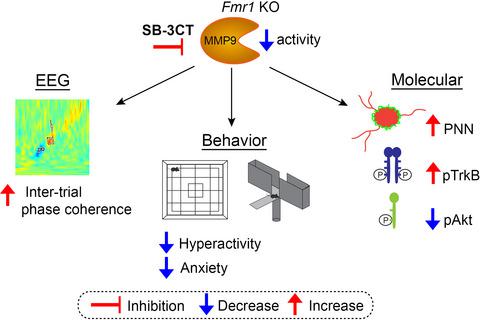当前位置:
X-MOL 学术
›
J. Neurochem.
›
论文详情
Our official English website, www.x-mol.net, welcomes your
feedback! (Note: you will need to create a separate account there.)
Acute pharmacological inhibition of matrix metalloproteinase-9 activity during development restores perineuronal net formation and normalizes auditory processing in Fmr1 KO mice.
Journal of Neurochemistry ( IF 4.2 ) Pub Date : 2020-05-06 , DOI: 10.1111/jnc.15037 Patricia S Pirbhoy 1 , Maham Rais 1 , Jonathan W Lovelace 2 , Walker Woodard 1 , Khaleel A Razak 2 , Devin K Binder 1 , Iryna M Ethell 1
Journal of Neurochemistry ( IF 4.2 ) Pub Date : 2020-05-06 , DOI: 10.1111/jnc.15037 Patricia S Pirbhoy 1 , Maham Rais 1 , Jonathan W Lovelace 2 , Walker Woodard 1 , Khaleel A Razak 2 , Devin K Binder 1 , Iryna M Ethell 1
Affiliation

|
Individuals with Fragile X Syndrome (FXS) and autism spectrum disorder (ASD) exhibit cognitive impairments, social deficits, increased anxiety, and sensory hyperexcitability. Previously, we showed that elevated levels of matrix metalloproteinase‐9 (MMP‐9) may contribute to abnormal development of parvalbumin (PV) interneurons and perineuronal nets (PNNs) in the developing auditory cortex (AC) of Fmr1 knock‐out (KO) mice, which likely underlie auditory hypersensitivity. Thus, MMP‐9 may serve as a potential target for treatment of auditory hypersensitivity in FXS. Here, we used the MMP‐2/9 inhibitor, SB‐3CT, to pharmacologically inhibit MMP‐9 activity during a specific developmental period and to test whether inhibition of MMP‐9 activity reverses neural oscillation deficits and behavioral impairments by enhancing PNN formation around PV cells in Fmr1 KO mice. Electroencephalography (EEG) was used to measure resting state and sound‐evoked electrocortical activity in auditory and frontal cortices of postnatal day (P)22–23 male mice before and one‐day after treatment with SB‐3CT (25 mg/kg) or vehicle. At P27‐28, animal behaviors were tested to measure the effects of the treatment on anxiety and hyperactivity. Results show that acute inhibition of MMP‐9 activity improved evoked synchronization to auditory stimuli and ameliorated mouse behavioral deficits. MMP‐9 inhibition enhanced PNN formation, increased PV levels and TrkB phosphorylation yet reduced Akt phosphorylation in the AC of Fmr1 KO mice. Our results show that MMP‐9 inhibition during early postnatal development is beneficial in reducing some auditory processing deficits in the FXS mouse model and may serve as a candidate therapeutic for reversing sensory hypersensitivity in FXS and possibly other ASDs.
中文翻译:

在发育过程中对基质金属蛋白酶 9 活性的急性药理学抑制可恢复 Fmr1 KO 小鼠的神经周围网形成并使听觉处理正常化。
患有脆性 X 综合征 (FXS) 和自闭症谱系障碍 (ASD) 的个体表现出认知障碍、社交缺陷、焦虑增加和感觉过度兴奋。以前,我们表明基质金属蛋白酶-9 (MMP-9) 水平升高可能导致 Fmr1 发育中的听觉皮层 (AC)中小白蛋白 (PV) 中间神经元和神经周网络 (PNN) 的异常发育敲除 (KO) 小鼠,这可能是听觉过敏的基础。因此,MMP-9 可作为治疗 FXS 中听觉过敏症的潜在靶点。在这里,我们使用 MMP-2/9 抑制剂 SB-3CT 在特定发育时期从药理学上抑制 MMP-9 活性,并测试抑制 MMP-9 活性是否通过增强周围的 PNN 形成来逆转神经振荡缺陷和行为障碍。Fmr1 中的光伏电池KO老鼠。使用脑电图 (EEG) 测量出生后天 (P) 22-23 只雄性小鼠在用 SB-3CT (25 mg/kg) 治疗前和治疗后一天的听觉和额叶皮层的静息状态和声音诱发的皮层电活动。车辆。在 P27-28,测试动物行为以测量治疗对焦虑和多动的影响。结果表明,MMP-9 活性的急性抑制改善了与听觉刺激的诱发同步并改善了小鼠的行为缺陷。MMP-9 抑制增强了 PNN 的形成,增加了 PV 水平和 TrkB 磷酸化,但降低了Fmr1的 AC 中的 Akt 磷酸化KO老鼠。我们的研究结果表明,出生后早期发育期间的 MMP-9 抑制有利于减少 FXS 小鼠模型中的一些听觉处理缺陷,并可作为逆转 FXS 和可能其他 ASD 中感觉超敏反应的候选疗法。
更新日期:2020-05-06
中文翻译:

在发育过程中对基质金属蛋白酶 9 活性的急性药理学抑制可恢复 Fmr1 KO 小鼠的神经周围网形成并使听觉处理正常化。
患有脆性 X 综合征 (FXS) 和自闭症谱系障碍 (ASD) 的个体表现出认知障碍、社交缺陷、焦虑增加和感觉过度兴奋。以前,我们表明基质金属蛋白酶-9 (MMP-9) 水平升高可能导致 Fmr1 发育中的听觉皮层 (AC)中小白蛋白 (PV) 中间神经元和神经周网络 (PNN) 的异常发育敲除 (KO) 小鼠,这可能是听觉过敏的基础。因此,MMP-9 可作为治疗 FXS 中听觉过敏症的潜在靶点。在这里,我们使用 MMP-2/9 抑制剂 SB-3CT 在特定发育时期从药理学上抑制 MMP-9 活性,并测试抑制 MMP-9 活性是否通过增强周围的 PNN 形成来逆转神经振荡缺陷和行为障碍。Fmr1 中的光伏电池KO老鼠。使用脑电图 (EEG) 测量出生后天 (P) 22-23 只雄性小鼠在用 SB-3CT (25 mg/kg) 治疗前和治疗后一天的听觉和额叶皮层的静息状态和声音诱发的皮层电活动。车辆。在 P27-28,测试动物行为以测量治疗对焦虑和多动的影响。结果表明,MMP-9 活性的急性抑制改善了与听觉刺激的诱发同步并改善了小鼠的行为缺陷。MMP-9 抑制增强了 PNN 的形成,增加了 PV 水平和 TrkB 磷酸化,但降低了Fmr1的 AC 中的 Akt 磷酸化KO老鼠。我们的研究结果表明,出生后早期发育期间的 MMP-9 抑制有利于减少 FXS 小鼠模型中的一些听觉处理缺陷,并可作为逆转 FXS 和可能其他 ASD 中感觉超敏反应的候选疗法。











































 京公网安备 11010802027423号
京公网安备 11010802027423号